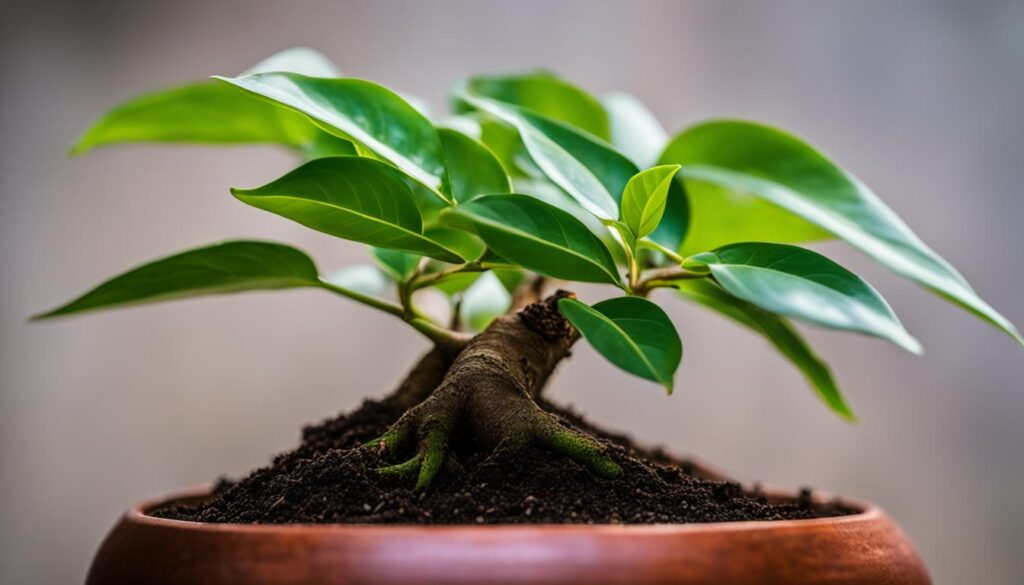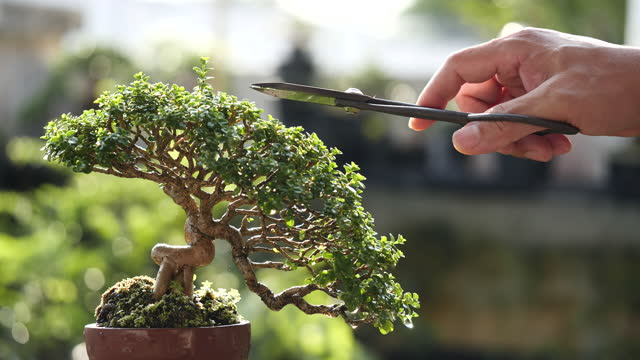With their beautiful foliage and intricate root systems, this genus is a popular choice for bonsai lovers. From the majestic Ficus Retusa with its stately S-curved trunk to the graceful Ficus Benjamina with its weeping branches, each species brings its own charm and beauty to your bonsai collection.
In this guide, we will cover topics such as placement, lighting, watering, fertilizing, pruning and shaping techniques, as well as essential care tips to ensure your Ficus bonsai thrives. We will also discuss how to acquire one, combat pests and diseases, and appreciate the unique aerial roots and growths that make these trees truly special.
So, whether you’re looking to add a Ficus bonsai to your collection or already have one at home, this guide will be your go-to resource for everything related to Ficus bonsai care. Let’s dive in and discover the beauty and artistry of these mesmerizing miniature trees!
Diversity of Ficus Bonsai Species
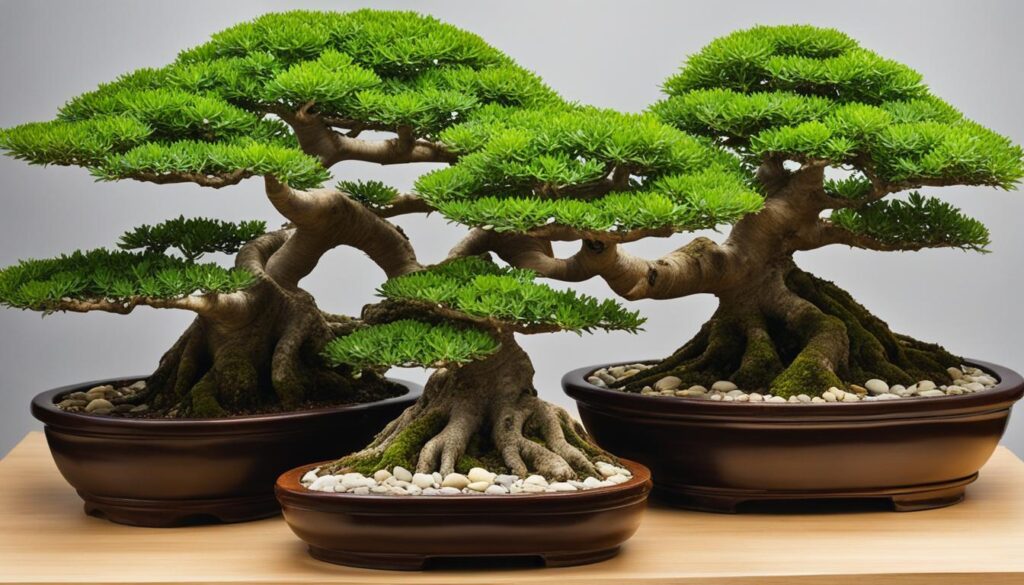
When it comes to Ficus bonsai, there is a wide range of diverse and captivating species to explore. Each species offers unique characteristics and features, making them a fascinating choice for bonsai enthusiasts. Let’s delve into the details of some popular Ficus bonsai species:
Ficus Retusa (Ficus microcarpa) – The Stately S-Curved Bonsai
Ficus Retusa, also known as Ficus microcarpa, is a species that exhibits an elegant S-curved trunk, creating a distinctive and eye-catching aesthetic. Its glossy, dark green leaves add to its appeal, and it is known for its ability to develop aerial roots, enhancing its natural and striking appearance and it is also a rapidly growing plant. This species requires bright, indirect light and regular pruning to maintain its desired shape.
Ficus Benjamina – The Graceful Weeper
Ficus Benjamina, often referred to as the Weeping Fig, showcases gracefully drooping branches and cascading leaves, giving it a stunning and elegant appearance. Its small, ovate leaves are bright green, which beautifully contrasts with its pale, tan bark. This species requires ample sunlight and consistent moisture to thrive, but it’s important to avoid overwatering as it can lead to root rot.
Ficus Ginseng (‘Ginseng’)
Ficus Ginseng, also known as ‘Ginseng’, is one of the most popular bonsai species due to its unique and visually striking appearance. Its thick, bulbous trunk and intricate root system create a captivating bonsai that is often referred to as the “Ginseng Bonsai.” This species requires bright, indirect light, and proper watering techniques are crucial, as the soil should be allowed to dry out slightly between waterings.
Ficus Salicaria – Sleek Leaves and Elegant Form
The Ficus Salicaria, also known as the Willow Leaf Fig, boasts slender, elongated leaves and a graceful, upright form. Its glossy, dark green foliage and its ability to withstand various indoor conditions make it a popular choice for bonsai enthusiasts. This species thrives in bright, indirect light and requires regular pruning to maintain its sleek and elegant appearance.
Ficus Aurea – Florida’s Strangling Fig
Ficus Aurea, commonly known as the Florida Strangling Fig, is a unique species renowned for its aerial roots, which often grow downward from its branches to the ground, creating an impressive and distinctive visual display. Its small, oval-shaped leaves have a vibrant green color, and its gnarled trunk adds character and charm to this bonsai. This species requires bright, indirect light and proper humidity levels to flourish.
Each of these species offers its own allure and can add beauty to any bonsai collection. By understanding the specific characteristics and care requirements of each species, you can ensure the proper nurturing and growth of your bonsai.
Unique Traits of Ficus Bonsai Varieties
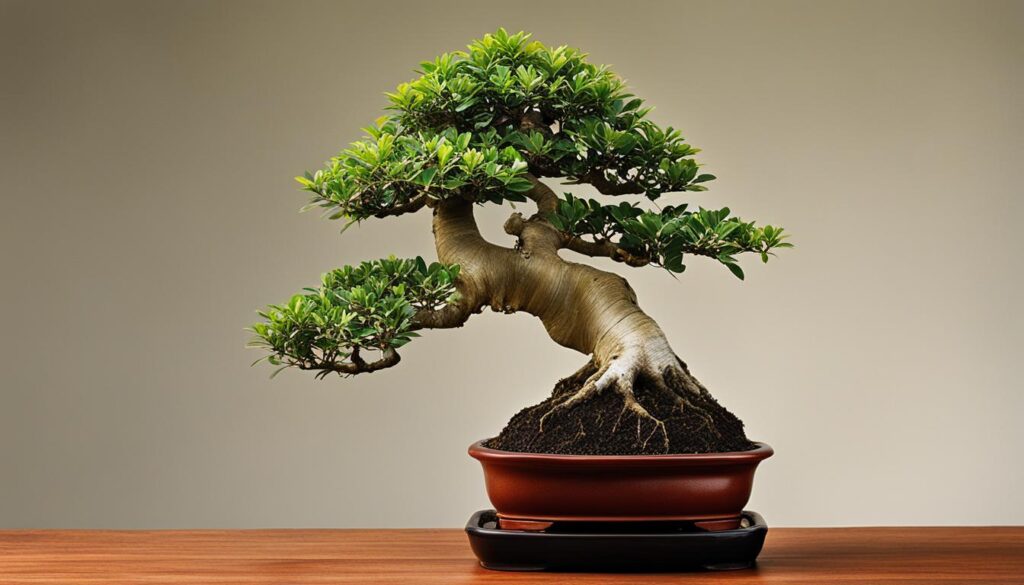
When it comes to Ficus bonsai, the variety of options available to bonsai enthusiasts is truly remarkable. Each variety of Ficus bonsai exhibits unique traits that set it apart from the rest. From different growth patterns to distinctive leaf shapes and even bark texture, there is something for every bonsai lover.
Let’s explore the fascinating world of Ficus bonsai varieties and uncover their exceptional features. Whether you prefer a bonsai with intricate aerial roots, elegant weeping branches, or sleek leaves, there is a Ficus bonsai variety that will capture your heart.
“The beauty of Ficus bonsai lies in their diversity. Each variety tells a unique story, offering an opportunity to create a truly one-of-a-kind masterpiece.”
One of the distinguishing factors among Ficus bonsai varieties is their growth patterns. Some varieties grow in a graceful weeping form, with cascading branches that create an elegant silhouette. Others exhibit stately S-curved trunks that add a sense of grandeur to any bonsai collection.
Leaf shape is another remarkable trait of Ficus bonsai varieties. While some varieties showcase small and compact leaves, others feature larger and more elongated leaves, adding visual interest and texture to the bonsai. The diversity of leaf shapes allows bonsai enthusiasts to express their artistic vision in countless ways.
The texture of the bark is yet another captivating feature of Ficus bonsai varieties. Some varieties develop smooth and polished bark, creating a refined and sophisticated appearance. In contrast, others display rough and textured bark that gives the bonsai a rugged and aged look. The bark texture adds depth and character to the bonsai, making it truly unique.
Selecting the right Ficus bonsai variety is a personal journey, based on individual preferences and desired aesthetics. Whether you are drawn to the intricate aerial roots of the Ficus Retusa or the sleek leaves of the Ficus Salicaria, each variety offers its own distinct charm.
Choosing Your Ficus Bonsai Species
Consider the following factors when choosing your Ficus bonsai species:
- Leaf shape and size
- Growth pattern
- Bark texture
- Aesthetic appeal
By understanding the unique traits of each species, you can make an informed decision and select the variety that best resonates with your artistic vision and personal preferences.
| Ficus Bonsai Species | Unique Traits |
|---|---|
| Ficus Retusa | Stately S-Curved Trunks, Aerial Roots |
| Ficus Benjamina | Graceful Weeping Form, Small Leaves |
| Ficus Ginseng | Thick Trunk, Aerial Roots |
| Ficus Salicaria | Sleek Leaves, Smooth Bark |
| Ficus Aurea | Textured Bark |
Table: Unique Traits of Ficus Bonsai Species
Essential Ficus Bonsai Care for Thriving Plants
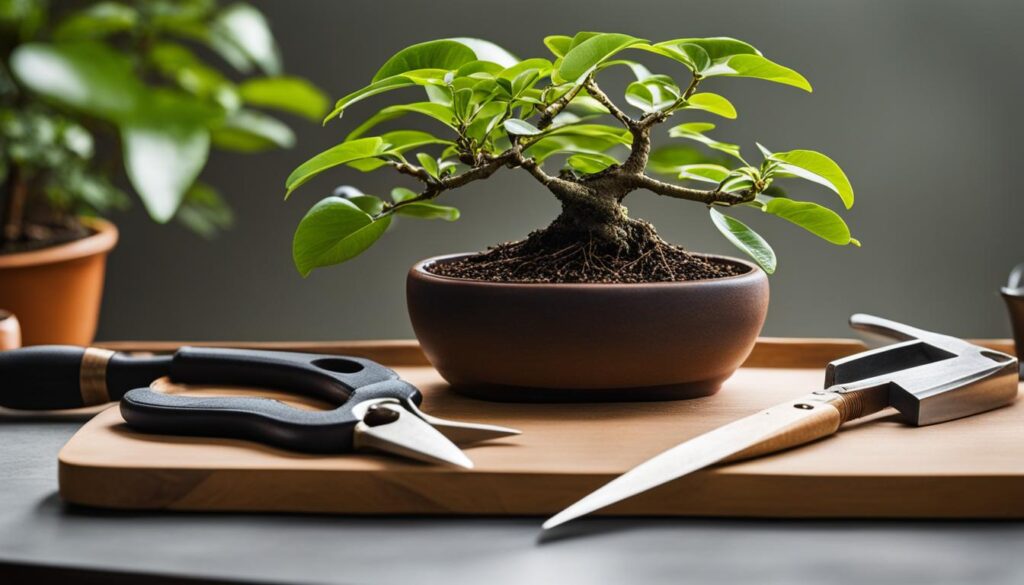
Proper care is crucial for the health and vitality of your Ficus bonsai. By following essential care guidelines, you can ensure that your bonsai thrives and displays its natural beauty. Here are some important care tips to keep in mind:
- Watering: Ficus bonsai plants require regular watering to maintain optimal health. It’s important to water your bonsai when the soil surface starts to dry out. However, be cautious not to overwater, as excessive moisture can lead to root rot. To determine the watering frequency, check the moisture level of the soil by gently inserting your finger about an inch deep. If the soil feels slightly damp, wait a little longer before watering.
- Fertilizing: Ficus bonsai benefit from regular fertilization to support their growth and development. Use a balanced, slow-release fertilizer specifically formulated for bonsai plants. Follow the recommended dosage instructions on the fertilizer packaging and apply it during the growing season. Avoid fertilizing during winter dormancy.
- Lighting: Ficus bonsai thrive in bright, indirect light. Place your bonsai near a window with filtered light or provide supplemental artificial lighting, especially during the winter months. Avoid exposing your bonsai to direct sunlight for extended periods, as it can scorch the leaves.
- Temperature: Ficus bonsai prefer a moderate temperature range between 60°F and 75°F (15°C to 24°C). Protect your bonsai from extreme temperatures, both hot and cold. Sudden temperature fluctuations can cause stress and impact the overall health of your bonsai.
- Pruning and Shaping: Regular pruning and shaping are essential for maintaining the desired form and aesthetics of your Ficus bonsai. Remove any dead, damaged, or overgrown branches and foliage to promote healthy growth. Additionally, use wiring and shaping techniques to guide the branches into the desired positions.
By adhering to these care practices, you can ensure that your Ficus bonsai remains healthy and vibrant. Remember to pay attention to your bonsai’s individual needs and make adjustments accordingly. With proper care, your Ficus bonsai will continue to thrive and bring beauty to your space.
Placement and Light for Ficus Bonsai Health
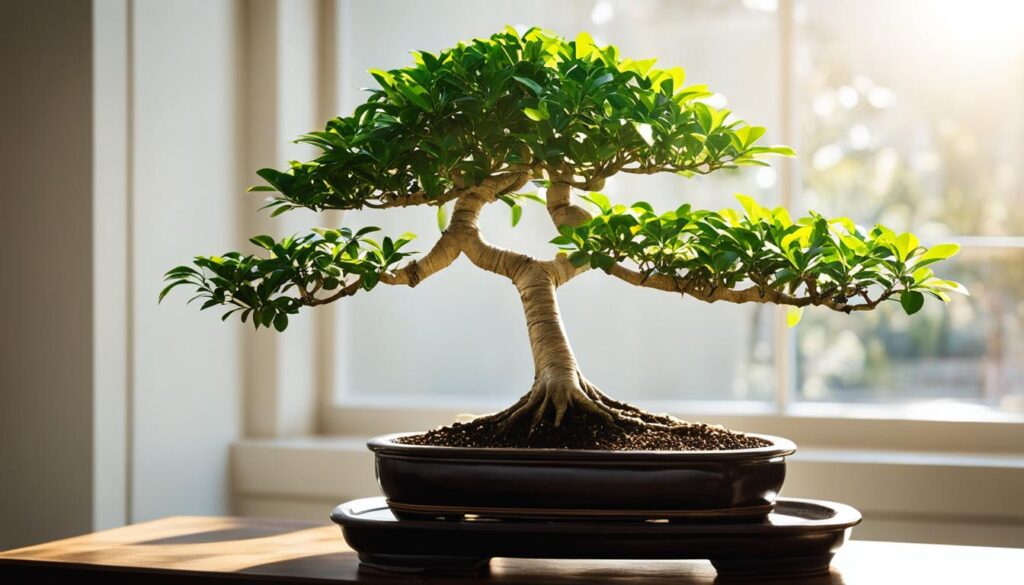
Proper placement and lighting are essential for maintaining the health and vitality of your Ficus bonsai. The right placement and adequate light exposure can promote healthy growth and prevent common issues like leaf drop or leggy growth.
When it comes to placement, Ficus bonsai thrive both indoors and outdoors. Indoors, choose a location that offers bright, indirect light. Avoid placing your bonsai near drafts or in areas with extreme temperature fluctuations. Ensure that the room is well-ventilated to prevent stagnant air and promote healthy growth.
If you choose to keep your Ficus bonsai outdoors, select a spot that receives filtered sunlight or partial shade. Avoid direct, intense sunlight, as it can scorch the leaves of your bonsai. Provide protection from strong winds, as they can cause dehydration and damage to the delicate foliage.
When it comes to light exposure, finding the right balance is crucial. Ficus bonsai thrive in bright, indirect light, but excessive light can lead to sunburn and leaf scorching. On the other hand, insufficient light can result in weak growth and sparse foliage.
To provide the optimal light conditions for your Ficus bonsai, consider the following tips:
- Place your bonsai near a north or east-facing window indoors to ensure it receives bright, indirect light.
- If your bonsai is placed further away from a window, consider using artificial grow lights to supplement the available light.
- Monitor the light intensity throughout the day and make adjustments as needed. Use sheer curtains or blinds to filter direct sunlight if necessary.
- If you keep your Ficus bonsai outdoors, provide shade during the hottest part of the day using a shade cloth or by placing it under a tree canopy.
Remember to regularly rotate your Ficus bonsai to ensure even light exposure on all sides and promote balanced growth. By paying attention to proper placement and light, you can help your Ficus bonsai thrive and maintain its health and beauty.
Watering Your Ficus Bonsai: A Delicate Balance
Proper watering is essential for maintaining the health and vitality of your Ficus bonsai. Finding the right balance can be a delicate task, as both overwatering and underwatering can have detrimental effects on your plant’s well-being. In this section, we will provide you with detailed guidance on watering your Ficus bonsai to ensure optimal growth and longevity.
Identifying When Your Ficus Bonsai is Thirsty
To keep your Ficus bonsai hydrated, it’s important to understand the signs that indicate it needs water. Here are some common indicators that your bonsai is thirsty:
- Visual cues: Look out for wilting or drooping leaves. If the leaves appear limp or have lost their healthy green color, your Ficus bonsai may be in need of water.
- Touch test: Gently touch the soil surface with your finger. If it feels dry to the touch, it’s likely time to water your bonsai. However, if the topsoil feels moist, it’s best to hold off on watering until it dries out slightly.
- Weighing method: Lift your bonsai pot and get familiar with its weight when properly watered. As the soil dries out, the pot will become lighter, indicating that it’s time for watering.
By observing these cues and developing a watering routine based on your Ficus bonsai’s specific needs, you can ensure that it receives adequate hydration.
Avoiding Common Watering Mistakes
When it comes to watering your Ficus bonsai, there are a few common mistakes that you should avoid:
- Overwatering: One of the most common mistakes is overwatering. Ficus bonsai prefer a slightly moist but well-drained soil. Overwatering can lead to root rot and other fungal issues. Only water your bonsai when the soil has partially dried out.
- Improper watering techniques: Avoid pouring water directly onto the foliage or trunk of your bonsai. Instead, water the soil slowly and evenly until the water starts draining out from the bottom of the pot.
- Neglecting environmental conditions: Adjust your watering frequency based on environmental conditions. Factors such as temperature, humidity, and season influence the water requirements of your bonsai. During hot and dry periods, you may need to water more frequently, while cooler and more humid conditions may require less frequent watering.
By avoiding these common mistakes and following the proper watering techniques, you can ensure the health and longevity of your Ficus bonsai.
| Common Watering Mistakes | How to Avoid Them |
|---|---|
| Overwatering | Water your bonsai only when the soil has partially dried out. Avoid saturating the soil. |
| Improper watering techniques | Water the soil slowly and evenly, avoiding direct contact with the foliage or trunk. |
| Neglecting environmental conditions | Adjust watering frequency based on temperature, humidity, and season. Monitor the soil’s moisture level. |
In conclusion, watering your Ficus bonsai requires a delicate balance. By identifying when your bonsai is thirsty and avoiding common watering mistakes, you can ensure its optimal health and growth. Remember to observe visual cues, perform the touch test, and develop a watering routine based on your bonsai’s specific needs. With proper watering, your Ficus bonsai will thrive and become a stunning centerpiece in your bonsai collection.
The Right Way to Fertilize Your Ficus Bonsai Tree
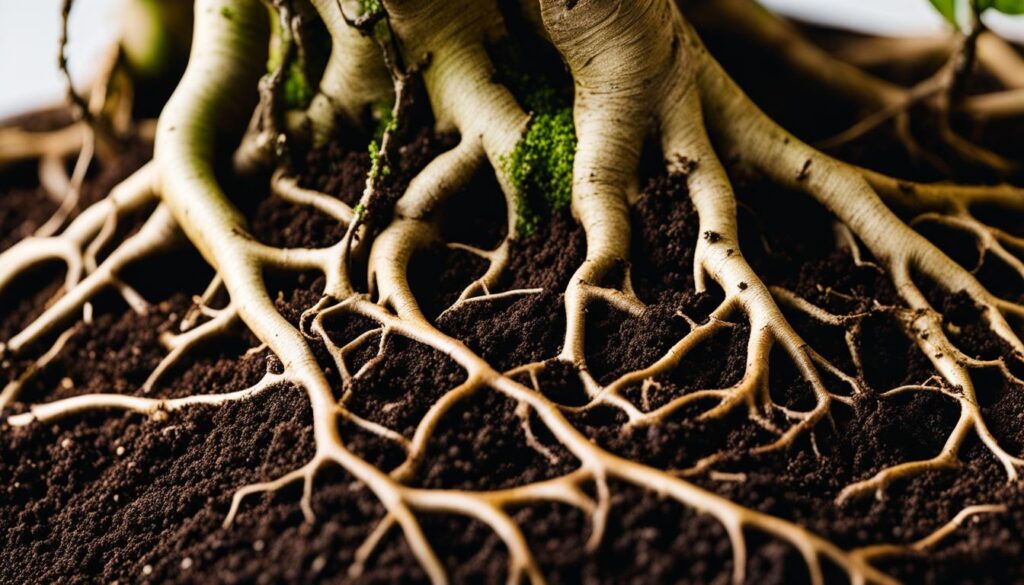
Fertilization is a crucial aspect of caring for your Ficus bonsai tree. Providing the right nutrients ensures optimal growth and overall health. In this section, we will explore the importance of fertilizing it and guide you on the proper techniques and schedule to follow.
Types of Fertilizers:
There are various types of fertilizers available for Ficus bonsai, including liquid, granular, and organic options. Liquid fertilizers are convenient and quickly absorbed by the roots, while granular fertilizers offer slow-release nutrients. Organic fertilizers provide natural nourishment, promoting long-term soil health. Choosing the right fertilizer depends on your preferences and the specific needs of your Ficus bonsai.
Fertilization Schedule:
The fertilization schedule for depends on the species and growth stage of your tree. As a general rule, it is recommended to fertilize Ficus bonsai during the growing season, typically from spring to early fall. However, it’s important to adjust the frequency based on the specific needs of your tree. A balanced fertilizer with a nitrogen-phosphorus-potassium (NPK) ratio of 10-10-10 or similar is suitable for most Ficus bonsai.
Applying Fertilizer:
To apply fertilizer to your, dilute liquid fertilizers according to the manufacturer’s instructions and water the tree with the solution. For granular fertilizers, follow the package instructions to determine the appropriate amount and sprinkle it evenly on the soil surface. Avoid direct contact with the trunk or foliage to prevent burning or damage.
Tips for Fertilizing:
- Always water your Ficus bonsai before applying fertilizer to ensure proper absorption.
- Avoid over-fertilizing, as it can lead to nutrient imbalances and harm the tree.
- Monitor the foliage and soil condition to assess if your Ficus bonsai requires additional fertilization.
- During the dormant period in winter, it’s best to reduce or entirely stop fertilization to allow the tree to rest.
Remember, proper fertilization is essential for the health and vigor of your Ficus bonsai tree. By understanding the right types of fertilizers, following a suitable schedule, and applying fertilizer correctly, you can ensure your bonsai thrives and remains beautiful for years to come.
Pruning and Shaping Techniques for Ficus Bonsai
When it comes to maintaining the desired form and aesthetics of your plant, proper pruning and shaping techniques are essential. By using the right tools and following the correct methods, you can create a stunning masterpiece that reflects your artistic vision.
To start, consider the different pruning purposes you may have for your Ficus bonsai. If you are looking to reduce the size of branches, use sharp pruning shears to carefully remove unwanted growth.
Leaf pruning can be achieved by pinching off individual leaves or removing entire clusters to encourage new growth. For trunk thickening, selective pruning can stimulate the growth of new branches and help achieve a more robust appearance.
Shaping your plant is another crucial aspect of maintaining its desired form. Wiring is a common technique used to guide the growth of branches and create natural bends. Wrap the wire gently around the branch, making sure not to damage the bark.
Guy-wires can also be used to support heavier branches and promote stronger growth. These techniques, when applied with care, can help you achieve the ideal shape and structure for your Ficus bonsai.

